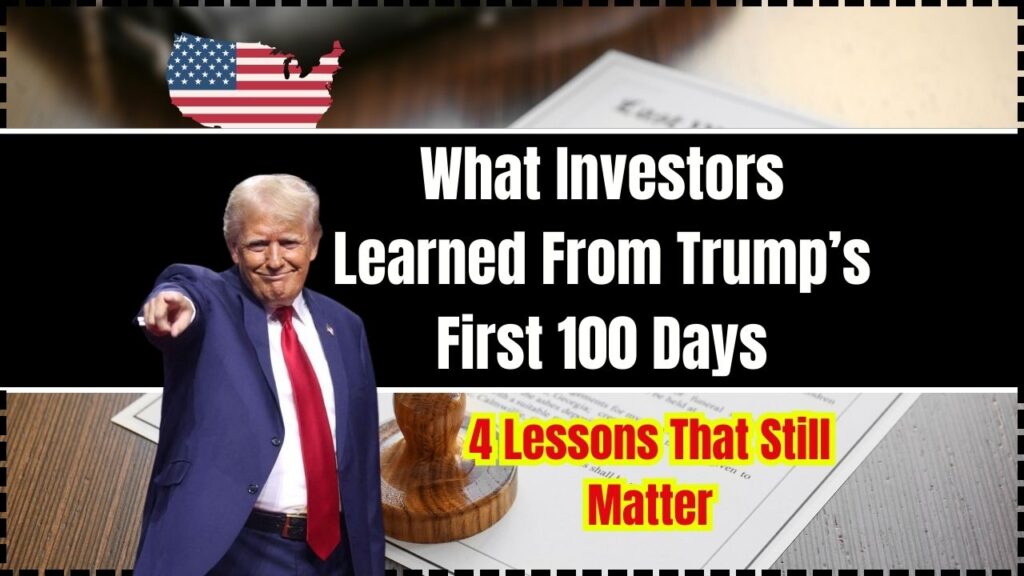
What Investors Learned From Trump’s First 100 Days? In the ever-evolving world of finance, the phrase “Trump’s first 100 days” still sparks debate among investors. Whether you’re a seasoned portfolio manager or just learning about stocks, the early months of Donald Trump’s presidency—particularly his second term in 2025—offered a masterclass in how quickly markets can turn based on policy. From unexpected tariffs to shifting trade strategies, Trump’s approach to governance sent tremors through Wall Street. Investors, economists, and analysts all took note. And while the storm may have passed, the lessons remain critical today.
What Investors Learned From Trump’s First 100 Days
The first 100 days of Trump’s second term offered a powerful reminder of how politics and policy can shake the markets. While volatility isn’t new, the lessons from this period remain evergreen: stay diversified, think long-term, track policy moves, and never let fear drive your investment decisions. By applying these lessons, you can turn uncertainty into opportunity—and build a more resilient financial future.
| Metric / Insight | Details |
|---|---|
| S&P 500 Performance | Dropped 7.3% in first 100 days — worst since 1974 |
| “Liberation Day” Market Event | April 2, 2025 – introduction of sweeping tariffs |
| Best-Performing Assets During Period | Gold (+20%), Treasury Bonds, Defensive Stocks |
| Investor Confidence | Declined due to policy unpredictability and market volatility |
| Historical Comparison | Second-worst 100-day performance in modern history |
| Official Resource | White House Archives |
A Rocky Start: The 2025 “Liberation Day” Shakeup
On April 2, 2025, President Trump stunned markets by announcing widespread tariffs on imports from key trade partners, including China, Germany, and Canada. Dubbed “Liberation Day,” this move was framed as a patriotic stand for American manufacturing—but Wall Street saw it as a red flag.
Investors reacted swiftly. The S&P 500 plummeted by 7.3% during the first 100 days of the term, marking the worst start to a presidency since Gerald Ford in 1974.
Lesson 1: Policy Shifts Can Rapidly Influence Markets
Markets crave certainty. When the administration introduced sudden and sweeping tariffs without clear strategy or diplomatic groundwork, it left investors scrambling. These kinds of unexpected shifts can drain confidence, spark selloffs, and ultimately rattle the broader economy.
Takeaway: Always be aware of how government actions—especially fiscal or trade policy—can influence sectors like manufacturing, tech, and energy.
Lesson 2: Diversification is Your Safety Net
While equities suffered, other assets flourished. Gold rose over 20%, and Treasury bonds became a safe haven for risk-averse investors.
What Worked:
- Gold and precious metals gained value
- Bonds remained stable amid equity chaos
- Defensive stocks (healthcare, utilities) fared better
Actionable Tip: Build a diversified portfolio. Even if stocks decline, other assets can cushion the blow. Diversification isn’t just smart—it’s necessary.
Lesson 3: Market Sentiment Reacts to Policy Consistency
During the first 100 days, Trump’s administration walked back or revised several tariff announcements. This inconsistency frustrated business leaders and added to market volatility.
Key Point: Investors like predictability. Sudden reversals or unclear policy goals increase perceived risk, prompting capital outflows and lowering valuations.
Lesson 4: Think Long-Term, Act Smart
Despite the rocky start, markets eventually recovered. Investors who panicked and sold early often missed out on the rebound.
Investing Rule: Avoid reactionary decisions based on short-term noise. Stick to your plan, rebalance wisely, and stay focused on long-term financial goals.
Historical Comparison: Trump vs. Other Presidents
Let’s put the numbers in perspective:
| President | S&P 500 in First 100 Days |
|---|---|
| Barack Obama (2009) | +7.4% |
| George W. Bush (2001) | -3.9% |
| Donald Trump (2017) | +5.3% |
| Donald Trump (2025) | -7.3% |
The sharp drop during Trump’s second term was a notable outlier, emphasizing how market expectations differ based on policy tone and global economic context.
Expert Opinions
Mohamed El-Erian, Chief Economic Advisor at Allianz, noted:
“Markets don’t fear change—they fear surprise. The lack of strategic follow-through during the first 100 days created unnecessary uncertainty.”
Liz Ann Sonders, Chief Investment Strategist at Charles Schwab, stated:
“Investors should always keep dry powder—cash or liquid assets—to seize opportunities during overreactions.”
What Investors Learned From Trump’s First 100 Days: 5 Steps to Navigate Political Risk
- Stay Informed
Follow reputable sources like Bloomberg, Reuters, and CNBC for real-time analysis. - Use Tools Like Economic Calendars
Track key events with resources such as the Investing.com Economic Calendar. - Diversify Across Geographies and Asset Classes
Don’t rely solely on U.S. equities. Consider international exposure and commodities. - Establish a Rebalancing Schedule
Don’t wait for panic. Set a regular check-in to adjust your portfolio based on long-term goals. - Consult a Fiduciary Financial Advisor
If you’re unsure how to allocate assets during uncertainty, get professional advice tailored to your goals.
Coin Collectors – Where Can I Find Donald Trump’s Bronze Medal?
Donald Trump’s Cost-Cutting Pledge Is Unraveling – What Went Wrong?
Federal Resignation Program Under Trump Moves Ahead After Legal Victory
Frequently Asked Questions (FAQs)
Q: Why did the market fall so sharply in 2025?
A: Primarily due to unexpected tariffs, global trade tensions, and lack of policy clarity, which spooked investors and led to a selloff.
Q: Is now a good time to invest in gold or bonds?
A: If market volatility increases, these can serve as safe havens. But always consider your personal risk tolerance and goals.
Q: Should I sell my stocks during a political crisis?
A: Historically, long-term investors are better served by staying invested and focusing on fundamentals rather than headlines.








